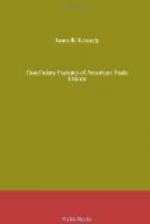The advantage of insurance as a means of securing identity of interest within the organization was not fully recognized in the early development of the insurance systems, consequently entrance into the insurance departments of these organizations was originally optional. The Brotherhood of Locomotive Firemen first adopted compulsory insurance at the fourth annual convention, 1878.[80] The Brotherhood of Railway Trainmen next adopted a similar feature in 1888. Although the Engineers and the Conductors did not enforce compulsory insurance until 1890 and 1891, respectively, during the twenty years preceding its adoption frequent proposals were made by subordinate divisions of both these organizations for the adoption of such an arrangement. On different occasions the national conventions considered the wisdom of such proposals, weighing in turn the advisability of such a measure and the ability of the organization to enforce it. The thorough discussion of the subject among the Engineers and the Conductors undoubtedly prepared the younger organizations for the settlement of this question at an earlier stage in their development. The Trainmen adopted compulsory insurance in 1888, while the two older organizations were in the midst of the struggle.
[Footnote 80: Locomotive Firemen’s Magazine, Vol. 21, p. 181.]
The Switchmen adopted it in 1892, and, after reorganization, again on October 1, 1901, and the Telegraphers on January 1, 1898. The Letter Carriers alone retain the system of optional insurance.
Only in the Switchmen’s Union and in the Brotherhood of Maintenance-of-Way Employees has the operation of the compulsory system met with interruption. The compulsory rule of the Maintenance-of-Way Employees during the early nineties was frequently repealed and readopted. The opposition to it was due in a large measure to uncertainty as to the number of yearly assessments necessary and also to the fact that many of the members carried insurance in old-line companies.[81] The Switchmen’s insurance department suffered a suspension from 1894 to 1897, and although the Union had compulsory insurance before its suspension, on reorganization a voluntary system was adopted, and not until October 1, 1901, did the Union succeed in reestablishing a compulsory system.
[Footnote 81: Advance Advocate, Vol. 5, p. 485.]
In all the organizations there is a class of members, called non-beneficiary, who are not eligible to the insurance departments because of partial disability or because of having passed the age limit. The Brotherhood of Locomotive Firemen provides that the non-beneficiary member shall be entitled to all the privileges of the subordinate lodge, but shall not take part in the national convention or in any way participate in the benefits and privileges of the beneficiary department.[82] Similar rules are found in the other brotherhoods. The Trainmen and the Switchmen issue to non-beneficiary members insurance certificates only against death in the sums of $500 and $600, respectively.




